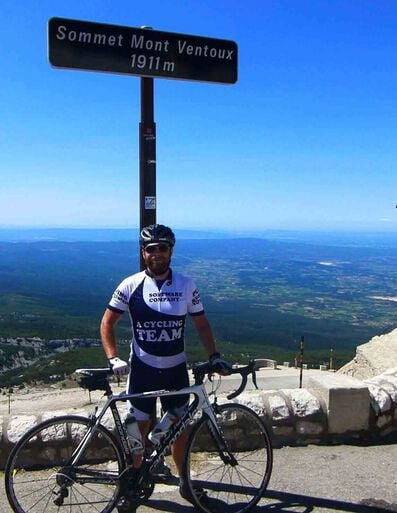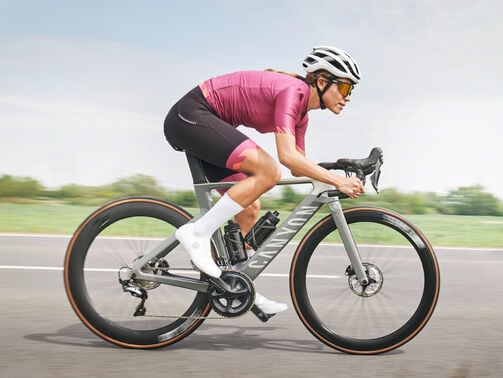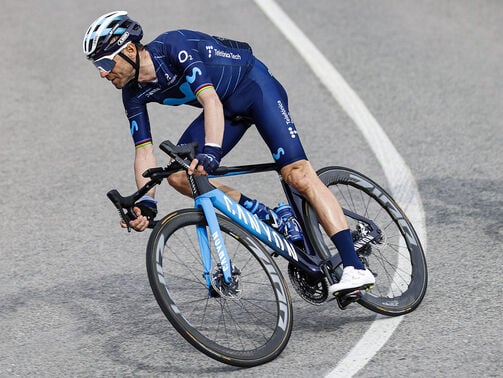How far will you go: Triathlon distances
A triathlon can be the ultimate test for endurance athletes. How far you go is up to you.


Many people dream of completing a triathlon, like the grandaddy of all triathlons, the Kona Ironman. Completing a marathon is a big enough challenge for most people, now imagine riding more than a century and swimming nearly 2.5 miles on top of that … in the same day! It boggles the mind, yet tens of thousands of people complete this challenge every year.
But what if you don’t have time to devote to completing a mammoth 140.6-mile race? Luckily, there are plenty of shorter distances that will not only check this achievement off your bucket list, but also still impress all your friends.
Canyon wants to help you achieve your goals, whatever distance they may be. New Zealand’s Hayden Wilde earned a silver medal at the Paris 2024 Olympics, thanks in part to a scorching bike leg atop a Canyon. Finding the right Canyon bike for your triathlon dreams has never been easier.
Contents
Sprint
- Total distance: 16 miles/26km
- Swim distance: .5 mile/750m
- Bike distance: 12.4 miles/20km
- Run distance: 3.1 miles/5k
Perhaps the best introduction to triathlon, a sprint triathlon is a fun challenge that practically anyone can do with a bit of training.
The Training You’ll Need
If you’re already at a decent fitness level on the bicycle, getting ready for a sprint triathlon could be as simple as adding in two or three days of swimming and running training a few weeks before the event. Couch potatoes should probably plan for at least two months of training before their first sprint tri. A quick Google or YouTube search will offer plenty of free pre-triathlon workout plans, like this one from Triathlete Magazine.
The Equipment You’ll Need
Don’t buy a lot of gear before your first sprint triathlon; the distances are so short, you can likely get by with stuff you already own. Things you’ll definitely need – a swimsuit, goggles, a bicycle, helmet, and running shoes.
You don’t need to buy a tri-specific bike like the Speedmax (yet) to compete in your first sprint triathlons; most participants ride a standard road bike and more than a few folks ride the dusty hybrid or mountain bike that’s been hanging in their garage. If you don’t already own a bicycle, take a look at the Canyon Endurace. It’s fast, comfortable to ride, and one of the most versatile road bikes on the market today.

Olympic
- Total distance: 32 miles/51.5km
- Swim distance: nearly 1 mile/1.5km
- Bike distance: 25 miles/40km
- Run distance: 6.2 miles/10 KM
About double the distance of a sprint triathlon, the Olympic-distance triathlon is at least twice as difficult and even more rewarding. Another doable challenge for most people, this triathlon distance often serves as a gateway to longer, more difficult races.
The Training You’ll Need
Expect to spend the 16-to-20 weeks before an Olympic-distance triathlon training. After building a solid base, training plans like this one from Triathlete Magazine, will have you steadily increasing your endurance and strength with some rest weeks and final taper built in.
The Equipment You’ll Need
In an Olympic-distance event, most athletes will be competing on tri-specific bikes or road bikes with clip-on aero bars allowing them to pedal in a more aerodynamic position. (Trying to decide between the various options? This article can help.) If you’re not looking to progress into longer races, a road bike like the Canyon Aeroad might be your best option, offering more versatility and multiple aero benefits while still maintaining the easier handling characteristics of a standard road bike. The Aeroad is ideal for competitors who fall in love with the cycling portion of the race more so than the two other legs.
Other changes you might notice in an Olympic-distance event – more competitors will be racing in tri-specific shorts or skinsuits. Depending on the time of year and location, some racers may even be wearing neoprene wetsuits that not only keep them warmer, but also add to their buoyancy. Most competitors will also use bike-specific shoes and clip-in pedals, before changing into standard running shoes for the final leg.
Half Ironman/Ironman 70.3
- Total distance: 70.3 miles/113.13km
- Swim distance: 1.2 miles/1.9km
- Bike distance: 56 miles/90km
- Run distance: 13.1 mile/21.1km
Now we’re getting serious. Only .01 percent of the population has done either a half or full Ironman-distance race. Will you be among them?
The Training You’ll Need
Starting with the base gained from one or more Olympic-distance events, already fit athletes can build up to a Half Ironman distance in as little as 10 weeks, according to this training plan from Triathlete. If you’re starting essentially from scratch, expect to spend 12-to-18 months preparing to go 70.3 miles, with most weekends and more than a few weekdays devoted to long training days.
The Equipment You’ll Need
Nearly all of the bicycles used in a 70.3- or 140.6-mile Ironman will be triathlon-specific and designed to do one thing: Go as fast as possible. One of the fastest bikes you can buy is the Canyon Speedmax. Everything about this bicycle – from the handlebars to the tube shapes to your position on it – is designed for aerodynamic benefit. (There’s a reason Canyon engineers spend so much time in wind tunnels.)
One of the biggest (and often overlooked) gear upgrades you can make is a more aerodynamic helmet, like the Abus x Canyon Gamechanger. Not only does the helmet reduce your drag, it also provides plenty of airflow to keep you cool when you’re burning down the road.

Ironman/Ironman 140.6
- Total distance: 140.6 miles/226.27km
- Swim distance: 2.4 miles/3.8km
- Bike distance: 112 miles/180km
- Run distance: 26.2 miles/42.2km
Many competitors dreaming of Kona will do their first 70.3-mile race and decide that’s enough for them. But some obsessions refuse to be extinguished. Completing a full Ironman event is the pinnacle of most competitors’ athletic dreams.
The Training You’ll Need
If you’re serious enough about completing an Ironman, you’ve probably hired a part-time coach by this point. But if not, Triathlete has a training plan for you. Unless you’ve built up a serious base by this time, expect to devote the time equivalent of a part-time job to Ironman training.
The Equipment You’ll Need
By this level, practically everyone is riding an ultra-aerodynamic, tri-specific bike. The faster you are, the more aerodynamics come into play. The Speedmax will knock seconds or even minutes off your bike split, making it one of the easiest ways to get faster with no added effort. According to testing done by the Global Triathlon Network YouTube channel, an athlete can save nearly 50 watts when pedaling at 30kph and up to a staggering 150 watts when pedaling at 45kph due to the aerodynamic design of the bike and their body positioning on it. Over the course of an Ironman- or Half Ironman-length course, those time and power savings really add up.
Ultra-Distances
Completing an Ironman is difficult enough, but some crazy athletes feel the need to push themselves even further. The distances for an ultra triathlon vary wildly – some extend the standard Ironman by double, triple, or even more. Others repeat the Ironman distances, and the winner is the hardy participant who managed to complete the most mileage for the day or weekend. The ultra-distances are for the truly obsessed.
No matter what distance you choose to compete in, after you cross the finish line, you’ll officially be a triathlete.

Did this article help?
Thank you for your feedback
-
 About the author
About the authorRobert Annis
Robert Annis is an award-winning outdoor-travel journalist. As an experienced writer and sport enthusiast he writes content that is inspiring with focus on road biking. You might have read Robert's articles in Bicycling, National Geographic, Outside, Travel + Leisure, Inside Hook, AARP, Midwest Living, Sierra, Hemispheres, Departures, Lonely Planet, Afar, Los Angeles Times, Chicago Tribune, RV Magazine, and Hidden Compass.




